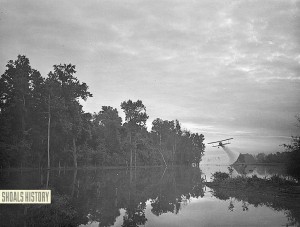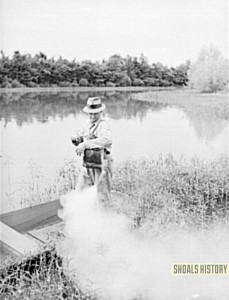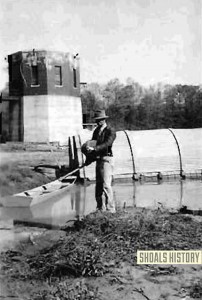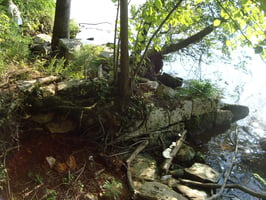Tuscumbia Landing: A Gateway to the West
Spring Creek Lighthouse or Malaria Control Base in Sheffield, Alabama?

What many locals refer to as Sheffield, Alabama’s Spring Creek Lighthouse is actually a Malaria Control base that was utilized by the Tennessee Valley Authority to combat the malaria outbreak plaguing 30 percent of the nearby population in the mid-late 1930s.
During the construction of the Nitrate Plants during the war, the population of Muscle Shoals skyrocketed to become the fourth largest town in Alabama within a matter of months. The population went from just 300 in January 1918 to 21,000 people by August of that same year. During the peak of activity at the nitrate plant site, there were 23 mess halls employing nearly 1,000 to prepare meals. Conditions of the rapidly expanding town were initially difficult, and the area became plagued with pneumonia, typhoid, malaria and the Spanish influenza.
U.S. President Franklin D. Roosevelt signed a bill that created the Tennessee Valley Authority (TVA) on May 18, 1933. This law gave the federal government a centralized body to control the Tennessee River’s potential for hydroelectric power and improve the land and waterways for development of the region. An organized and effective malaria control program stemmed from this new authority in the Tennessee River valley and one of the 4 bases of operation was right here in Sheffield on Spring Creek.
Malaria affected 30 percent of the population in the region when the TVA was incorporated in 1933. In 1938, about lO,OOO deaths and staggering economic losses were caused by malaria fever. The Public Health Service played a vital role in the research and control operations and by 1947, the disease was essentially eliminated. Mosquito breeding sites were reduced by controlling water levels and by intensive insecticide applications.
TVA’s efforts to combat this malaria outbreak involved the largest collection of engineers and experts working to fight malaria in the United States. As malaria rates began to decline, the TVA began to receive praise for its strong efforts. The CDC even lists the TVA’s accomplishments on its malaria history website.
On large reservoirs like Pickwick, it was necessary to supplement “biological control” of malaria-carrying mosquitoes with larvicidal measures. Facilities for larvicidal measures were constructed for the Pickwick Reservoir under the planning and supervision of the Malaria Control Division of the Tennessee Valley Authority. Two principal larvicides, an oil (kerosene-based) and a dust called “Paris green” (arsenic-based, see recipe below), were used on the Pickwick project.
The oil used was a mixture of 4-parts kerosene and 1-part black oil. The purpose of adding the black oil was to give the mixture a color in order for TVA to observe and measure the rate of it’s application. The kerosene-oil mixture was applied with knapsack spray cans as well as in “water-oil” boat units. For the Pickwick Reservoir, a total of fourteen of these water oil boats were constructed along with four warehouse bases and docks located about the reservoir from which to carry out the larvicidal program.
The dust was applied with a knapsack hand dust blowers and mechanical dusters placed in boats. The Tennessee Valley Authority also had available two Stearman Biplane dusters for this mosquito control operation on the Pickwick Reservoir.
One of these four malaria control bases is still standing on Spring Creek in Sheffield, Alabama. Each of the bases were equipped with a floating boat house, a dock, a tool storage building, a 1,OOO-gallon gasoline tank with pump, a 6,OOO-gallon larvicidal oil storage tank and small tools that were necessary for minor repair work. Each base was provided with a safe water supply and sanitation facilities conforming to Health Department regulations.

The Paris Green Dust Recipe:
The mixture called “Paris green” contained at least 50 percent arsenious oxide (Arsenic) and it’s recipe specified: “no more than 3-1/2 percent being soluble in water, and of such fineness that 100 percent will pass 200-mesh screen, and 85 per cent pass 300-mesh screen, and that; the product be toxic to Anopheles larvae (mosquitoes) in natural breeding places.”




